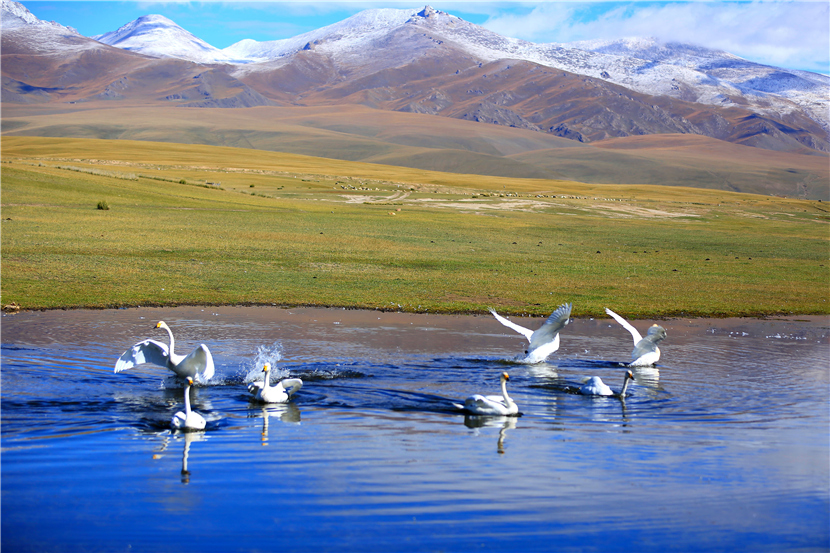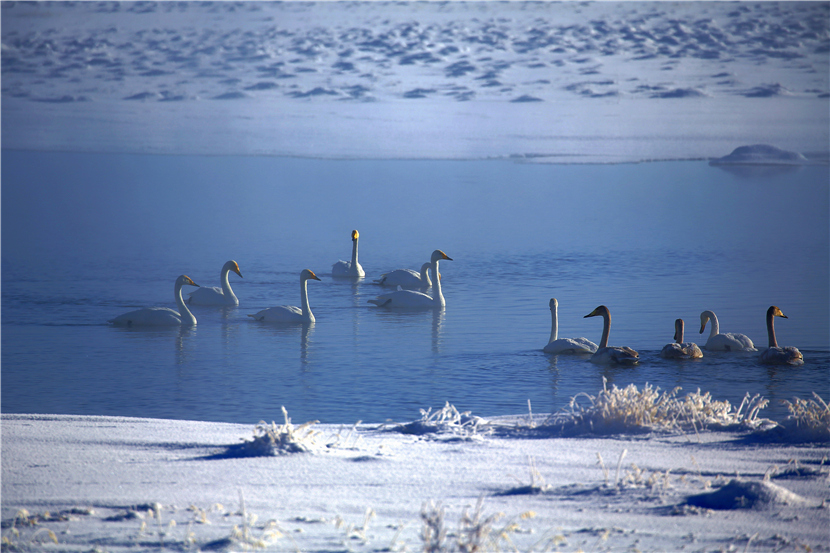The scenic area show cases the world heritage value of Tianshan with its alpine wetland ecosystem and the beauty of meandering and swampy wetland landscapes. It has importance and representativeness in geographical location, and rarity and diversity in landscape.
The scenic area is known as the "Green Pure Land" due to its unique natural ecological and cultural landscapes, and is the location of the largest subalpine alpine meadow grassland in China. The scenic area includes one of the "Xinjiang .Tianshan" World Natural Heritage Sites, the largest national swan nature reserve in China-Swan Lake, and a top-notch scenic spot in China, the Kaidu River's Jiuqu 18 Bays; Bayinbuluke Town, one of the first batch of characteristic scenic tourist towns in China and the most beautiful village in China. The scenic area has landscapes such as Grassland Love, Swan Homeland, Zakstai Bird Watching Platform, Barun Kure, Brasilik Viewing Platform, Grassland Holy Mountain Taglen Mountain, and Hu Shen Kure. It is an ecological tourism scenic area that integrates hills, basins, grasslands, and wetlands, and is known as the "most fertile and beautiful pasture at the southern foot of Tianshan Mountain". Bayinbuluke is also the place where the Turgut tribe of Western Mongolia returned to the east, nurturing a strong regional culture and grassland nomadic culture.

Writer Luo Juan wrote in her travel notes: "Running towards the Bayinbuluke Grassland, all beauty appears distant due to the open field of vision. Of course, when you chase after the cloud, you find it always in a place where you can reach out and pick it, and a cool wind will make the clouds bloom, like delicate flowers in the fields. Tianshan, wearing a snow crown, stands tall and shining at noon, and the golden light overflows when the sunset sets. It becomes the height you look up to on your journey, and it is also the spiritual support that this grassland relies on to continue".
Only when you reach Bayanbulak will you understand how harmonious the free and unrestrained life is with the eternal and mysterious atmosphere that nourishes the vast land. The Bayinbuluke Grassland not only has natural beauty, but also rich cultural heritage.
The grassland is closely related to a story about going home. In 1771, after more than 140 years of nomadic activity in the Volga River basin, the Turkut people who migrated westward were led by Ottawa and returned to their homeland after experiencing difficulties and hardships. After the return of the Turhute tribe, the Qing government arranged for their pastures, and the Jingyuledus grassland became the center of the returning tribe.

In the autumn and winter of the year when the Turgoth tribe returned, smallpox became popular among the tribes of Wobashi. Within a few months, the number of deaths reached thousands, and Wobashi himself was also infected with smallpox and passed away on January 9, 1775. On his deathbed, he left a will with the Turgoth people: "Live a peaceful life, diligently graze, avoid any trouble, and hope to pray." This indicates his wish and blessing for the sanctity and beauty of his motherland.
Nowadays, the Bayinbuluke Grassland is inhabited by nine ethnic groups, including the Mongols, Han, Tibetans, and Kazakhs, with a brilliant and colorful ethnic atmosphere.

From the fourth to sixth day of the sixth lunar month, you can attend the annual grassland festival "Nadam Festival" in Bayinbuluke, where you can watch traditional performances such as horse racing, wrestling, sheep racing, yak racing, ethnic costumes, and ethnic songs and dances. During this period, a large number of tourists entered the Bayanbuluke Grassland to experience the jubilant grasslands, appreciate the vigorous and graceful horses of the Bayanbuluke Mountains, the steady and unrestrained black headed sheep and yellow headed sheep unique to the Bayanbuluke Grassland, the ferocity of the Bayanbuluke Tianshan Wild Blood Yak, exceptional wrestlers, skilled folk artists, and the singing voice of the grassland nightingale. In addition, you can also purchase souvenirs with ethnic colors at the material exchange meeting.
On the fourth day of the sixth lunar month, you can participate in the local Donggui Nadam Art Festival. The fourth day of June is a traditional festival of the Mongolian Turkute people - the "Taglin Festival", which is the "Aobao" for the Turkute Mongolian people to worship and pray for blessings. The "Taglin Festival" is also known as the Aobao Festival. The Donggui Nadam Art Festival, also known as the "Tagrang Festival", opens with a ceremony of "Sacrificing the Aobao". On that day, on Mount Taglin, a lama wearing a cassock and wielding a law enforcement implement sat outside a yurt early in the morning, reciting sutras and offering sacrifices to the Buddha. Mongolian and Tibetan believers, dressed in formal attire and wrapped in cigarette chains, walk around the largest oboo on the grassland to recite scriptures, hang prayer flags, worship Buddha and gods, and bless each other, in order to achieve peace in the mountains and rivers, and prosperity for both humans and animals. Afterwards, horse racing, wrestling, archery, yak racing, camel racing, sheep fighting, sheep picking, clothing performances, and folk art exhibitions followed one after another... The grassland immediately became boiling. These competition activities on the imitation grassland make visitors linger and forget to return.




 Address: Hejing County, Bayingolin Mongolian Autonomous Prefecture, Xinjiang Uygur Autonomous Region Copyright: Bayinbuluke Scenic Area Management Committee, Hejing County
Address: Hejing County, Bayingolin Mongolian Autonomous Prefecture, Xinjiang Uygur Autonomous Region Copyright: Bayinbuluke Scenic Area Management Committee, Hejing County 

